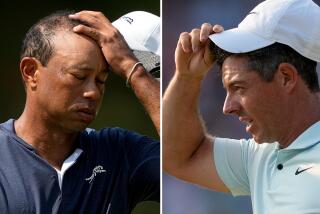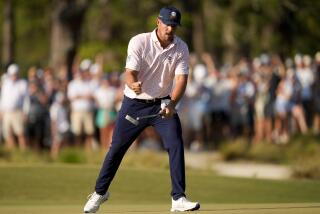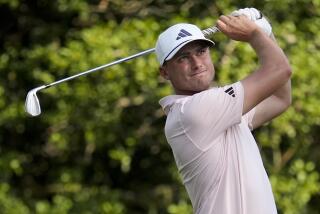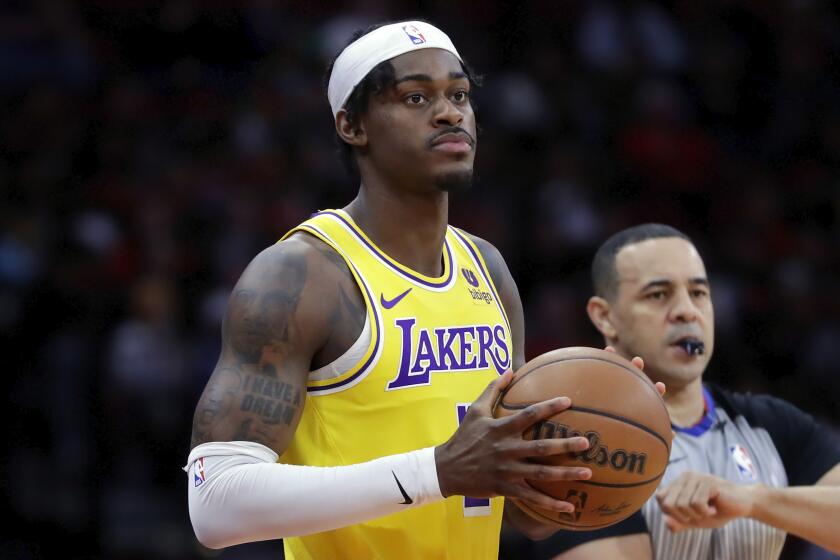Open Debate
- Share via
OLYMPIA FIELDS, Ill. — John Daly swatted a moving ball with his putter at Pinehurst No. 2 to protest tough conditions at the U.S. Open.
Tom Lehman was belligerent about the hole location on the 18th at Olympic Club. Nick Price was so angry about the 10th hole at Bethpage Black that he gave the USGA an F for course setup. “A pitiful effort,” he said.
Olin Browne was ticking off his list of favorite golf courses: Riviera, Colonial, Quail Hollow, Harbour Town, Westchester “and whatever course they play the U.S. Open on before the USGA gets ahold of it.”
Not a year goes by that someone doesn’t complain about something at the U.S. Open, the self-described “toughest test in golf.”
The man responsible for preparing the course is Tom Meeks, who makes few apologies.
“In a perfect world, I wish they would give me a hug and a kiss and said I did a good job. But that’s not going to happen,” said Meeks, the USGA’s senior director of rules and competition who has been setting up U.S. Open courses since 1996.
“It can’t happen when we do what we do -- try to determine the best player in the world,” Meeks said. “We’ve got to make it hard. And when we make it hard, it challenges them. If we don’t make it hard, why have a U.S. Open? We might as well run another PGA Tour event.”
The PGA Tour likes to say “these guys are good.” Out of 20 tour events this year, only at Riviera did the winner fail to reach double digits under par.
The U.S. Open requires these guys to be even better.
“You have to accept that you’re not going to make birdies at a U.S. Open,” Jeff Maggert said. “You come out here every week, play good, and you expect to make four, five or six birdies a round. You go there ... you can play perfect and not make one.”
Meeks took over the job of setting up U.S. Open courses in 1996 at Oakland Hills, where the rough was so deep there was a local rule for members in the two months leading up to the tournament.
Anyone who lost a ball in the rough could drop in the vicinity without penalty.
Every year, at least one par 5 gets turned into a long par 4. In 1997, it was No. 6 at Congressional, measuring 475 yards with a pond guarding the front of the green.
Larry Rinker was playing the course Friday before the U.S. Open and complained to Meeks that he had to hit driver, 3-wood just to reach the green.
“I told him, ‘Isn’t that great? You play all year on the PGA Tour and never get that chance,’ ” Meeks said.
The most valid complaint was in 1998, when Meeks set a back hole location on No. 18 at Olympic Club that was nearly unplayable because of the firm green.
Lehman watched a solid round turn into a 75. Payne Stewart had an 8-foot birdie putt that grazed the lip, then rolled some 25 feet down the hill. Kirk Triplett was so frustrated he stuck his putter in the ground to stop the rolling.
Meeks concedes it was his biggest mistake.
“If you have any doubts on a hole location, don’t use it,” Meeks said. “I went against my better judgment.”
Meeks took almost as many hits for last year’s setup at Bethpage, where the 10th hole required a 260-yard carry to reach the fairway. Several players hit their best drive and still wound up in thick grass short of the fairway.
“If we had a mulligan, we would have brought the fairway in another 15 yards,” Meeks said. “We had a wind on Friday that we very seldom get. I wouldn’t call that a whiff, but it was an eye-opener.”
Not many players in this U.S. Open have ever seen Olympia Fields. Almost all of them know what to expect, because Meeks has a blueprint for setting up the course.
“U.S. Open courses are good,” David Toms said. “They’d be unbelievable if they didn’t try to abuse you.”
Meeks wants it firm and fast -- on the fairways so that any drive off line will roll into the rough, and on the greens to make it imperative to land on the proper side of the hole.
He wants the rough to be deep and difficult.
Hole locations will be among the toughest that players see, even in a year in which the PGA Tour routinely sets them three and four paces from the edge.
The result will be a winning score not far from par.
Tiger Woods is the only player to finish a U.S. Open at double digits under par. He was 12 under at Pebble Beach, although no one else was better than 3 over par.
The U.S. Open demands supreme accuracy off the tee, skillful irons, a great short game, pressure putting -- and that’s only half of the equation. The key is for players to keep their wits over 72 holes.
“It’s driving the ball in the fairway, it’s putting and chipping and not going crazy,” Charles Howell III said. “It’s as simple as that. If you can play a whole U.S. Open and not beat your head in the wall once, you’ve probably done all right.”
That wasn’t the case for Jose Maria Olazabal at Pinehurst in 1999. He was so frustrated after his first-round 75 that he punched his hotel wall, broke his hand and withdrew.
No matter how Olympia Fields looks or plays, there figures to be complaints from some corner. After all, it’s the U.S. Open.
Perhaps it’s best to follow the advice of Lee Janzen, who said in 1998 at Olympic Club, “I come to the U.S. Open expecting nothing to be fair.”
He went on to win by two strokes.
*
U.S. Open Field
The 156-man field for the 103rd U.S. Open, to be played June 12-15 at Olympia Fields Country Club (players listed only in the first category for which they qualified):
U.S. Open Champions (10 years): Tiger Woods, Retief Goosen, Lee Janzen, Ernie Els, Corey Pavin.
U.S. Amateur champion and runner-up: Ricky Barnes, Hunter Mahan.
Masters champions (5 years): Mike Weir, Vijay Singh, Jose Maria Olazabal.
British Open champions (5 years): David Duval, Paul Lawrie, Mark O’Meara.
PGA champions (5 years): Rich Beem, David Toms.
2003 Players Championship: Davis Love III.
2002 U.S. Senior Open champion: Don Pooley.
Top 15 and ties from 2002 U.S. Open: Phil Mickelson, Jeff Maggert, Sergio Garcia, Scott Hoch, Nick Faldo, Billy Mayfair, Nick Price, Tom Byrum, Padraig Harrington, Peter Lonard, Jay Haas, Dudley Hart, Justin Leonard, Robert Allenby.
Top 30 from the 2002 PGA Tour money list: Jerry Kelly, Charles Howell III, Chris DiMarco, Fred Funk, Jim Furyk, Jeff Sluman, Shigeki Maruyama, K.J. Choi, Len Mattiace, Rocco Mediate, Chris Riley, John Rollins, Bob Estes, Kenny Perry, Loren Roberts, Scott McCarron, Steve Lowery.
Top 15 from the 2002 European tour Order of Merit: Colin Montgomerie, Eduardo Romero, Adam Scott, Michael Campbell, Justin Rose, Angel Cabrera, Thomas Bjorn, Trevor Immelman, Stephen Leaney.
Top 50 in the world ranking through Colonial: Darren Clarke, Scott Verplank, Brad Faxon, Fred Couples, Paul Casey, Stuart Appleby, Niclas Fasth, Steve Flesch, Kirk Triplett, Bernhard Langer.
Top two from 2002 Japanese tour money list, provided they are in top 75 in the world ranking: Toru Taniguchi.
Top two from 2002 Australasian tour money list, provided they are in the top 75 in the world ranking: Craig Parry.
Special exemptions: Tom Watson, Tom Kite, Hale Irwin.
Sectional qualifiers: Brian Davis, Tom Gillis, Chad Campbell, Stewart Cink, Tim Clark, Brad Elder, Mark Calcavecchia, Chris Smith, Joe Ogilvie, Geoff Ogilvy, Rory Sabbatini, Jonathan Kaye, Bob Tway, Dean Wilson, Tim Petrovic, J.P. Hayes, Jesper Parnevik, David Smail, Kevin Sutherland, Trip Kuehne, Maarten Lafeber, Grant Waite, Fredrik Jacobson, John Maginnes, Billy Andrade, Bill Haas, Rod Pampling, Hidemichi Tanaka, Marco Dawson, Joe Durant, Kent Jones, Joey Sindelar, Jonathan Byrd, Alex Cejka, Brandt Jobe, Neal Lancaster, Brett Quigley, Darron Stiles, Craig Bowden, Dan Forsman, Richard Johnson, Cliff Kresge, Spike McRoy, Larry Mize, Chez Reavie, Tommy Armour, Woody Austin, Jay Don Blake, Olin Browne, Robert Damron, Brian Henninger, Roland Thatcher, Bob Burns, Ian Leggatt, Brian Gay, Jay Williamson.
Local and sectional qualifiers: Christopher Baryla, Chris Anderson, Sean Murphy, Dicky Pride, Rob Bradley, John Holmes, Sean McCarty, Hiroshi Matsuo, Jason Knutzon, Bryce Molder, Roy Biancalana, Steve Gotsche, Tom Glissmeyer, Bret Guetz, Greg Hiller, Doug Dunakey, Alan Morin, Matt Seppanen, Cortney Brisson, Geoffrey Sisk, Ryan Dillon, Doug LaBelle, Mark Wurtz, Luke List, Anthony Arvidson, Bill Lunde, Rick Reinserg, Warren Schutte.
*
U.S. Open Facts
When: Friday-June 15.
Site: Olympia Fields Country Club.
The Course: Two-time British Open champion Willie Park Jr. designed Olympia Fields, which opened in 1923. The club’s first president was Amos Alonzo Stagg, then the University of Chicago football coach.
Length: 7,190 yards.
Par: 36-34--70.
Format: 72 holes, stroke play.
Cut: Top 60 and ties, and anyone within 10 strokes of the lead after 36 holes.
Playoff, if necessary: 18 holes (stroke play) on June 16.
Field: 156 (146 professionals, 10 amateurs).
Purse: $6 million.
Winner’s share: $1.08 million.
Defending champion: Tiger Woods.
Noteworthy: Since 1991, only one player has finished higher than 40th when defending his U.S. Open title as Tiger Woods tied for 12th in 2001.
Television: Thursday-Friday, 8 a.m. to noon, ESPN: noon to 2 p.m., NBC. Saturday-June 15, 10:30 a.m. to 5 p.m., NBC.
More to Read
Go beyond the scoreboard
Get the latest on L.A.'s teams in the daily Sports Report newsletter.
You may occasionally receive promotional content from the Los Angeles Times.










